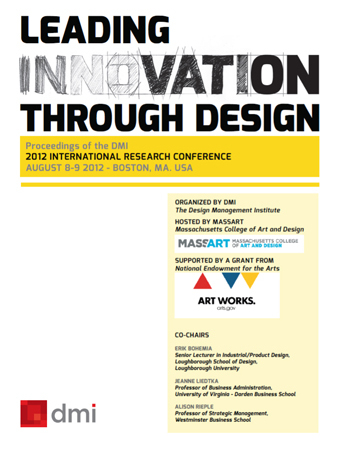The fuzzy front end of product design projects
 Proceedings of the Design Management Institute, conference, 2012; written with Peter Ford
Proceedings of the Design Management Institute, conference, 2012; written with Peter FordIn innovation, the simple transfer of knowledge isn’t enough – but uncertainty isn’t all bad
Co-authored between Peter Ford and James Woudhuysen, the FULL paper which can be downloaded below brings out a number of points about the fuzzy front end of new product development. Here’s some conclusions:
First, the management of knowledge in NPD is not just about knowledge being relayed from point to point, but also about it being originated. This ought to be obvious, given that a genuinely new product design or ‘discontinuous’ innovation might well be thought to embody new thinking; but the doctrine that innovation is largely and simply a clever combination of previous developments is all too fashionable nowadays (Woudhuysen, 2010:27). The significance of prototypes here also ought to be obvious. By its nature, a prototype is meant to test out new ideas, not just embody existing ones or lash them up together.
Second, a commercially experienced higher education institution can play the role of heavyweight product manager. It can manage and integrate the work of varied players and, in this work, can ensure not just that lines of communication are clear, but that whole new product concepts are developed and adhered to in the face of setbacks that are inevitable. A commercially experienced HEI can have the kind of clout, objectivity and balanced, comprehensive vision that can save time and money in NPD, and that a project manager internal to a client may not be able to muster. At the same time, HEIs have goals that go beyond time and money, a fact that can work to the advantage of clients.
Third, uncertainty at the FFE is something to be embraced, not feared. Again it should not need saying, but if there were no uncertainty, there would be no novelty. With company SE (handheld scientific equipment), a simple design facelift would have involved much less uncertainty – but would have led to much lower profits.
Fourth, uncertainty may surround not just user needs, technology, competition or the required resources, but also state regulation. The impact of regulation on NPD has almost certainly grown a great deal over the past 20 years, and closing information gaps about it was a key part of the Design Unit’s work with company SF (sports footwear with imported components that could have been subject to EU taxes), and with company KD (kneeling devices for healthcare professionals). Indeed, had company WT’s product gone forward, medical regulation would have been pivotal there as well.
Last, despite its relative absence from the literature on the FFE, the size of client companies matters. In the realm of construction, the category of the novice or inexperienced client has been shown to be relevant to the FFE (Tzortzopoulos, Cooper, Chan & Kagioglou, 2006: 658). That category pretty much describes how many small firms and not a few medium ones would see themselves.
The article can be downloaded by clicking on the The fuzzy front end of product design projects link.
"As transport secretary , caught driving sans insurance. As health sec, had a bizarre row with a nurse. Once, he asked female Ukrainian refugees: ‘Where are the men?’, forgetting how war had brought them to Scotland".
@FraserMyers at his funniest. CELEBRATE THE RARE GOOD NEWS!
It's a factory near Guildford, actually.
I first heard that joke when I shared a BT platform with Neil Hamilton, when he was still a Tory. The roadie said Neil's wife Christine was manufactured that way.
Unfair, but... who said life was fair?
Articles grouped by Tag
Bookmarks
Innovators I like

Robert Furchgott – discovered that nitric oxide transmits signals within the human body

Barry Marshall – showed that the bacterium Helicobacter pylori is the cause of most peptic ulcers, reversing decades of medical doctrine holding that ulcers were caused by stress, spicy foods, and too much acid

N Joseph Woodland – co-inventor of the barcode

Jocelyn Bell Burnell – she discovered the first radio pulsars

John Tyndall – the man who worked out why the sky was blue

Rosalind Franklin co-discovered the structure of DNA, with Crick and Watson

Rosalyn Sussman Yallow – development of radioimmunoassay (RIA), a method of quantifying minute amounts of biological substances in the body

Jonas Salk – discovery and development of the first successful polio vaccine

John Waterlow – discovered that lack of body potassium causes altitude sickness. First experiment: on himself

Werner Forssmann – the first man to insert a catheter into a human heart: his own

Bruce Bayer – scientist with Kodak whose invention of a colour filter array enabled digital imaging sensors to capture colour

Yuri Gagarin – first man in space. My piece of fandom: http://www.spiked-online.com/newsite/article/10421

Sir Godfrey Hounsfield – inventor, with Robert Ledley, of the CAT scanner

Martin Cooper – inventor of the mobile phone

George Devol – 'father of robotics’ who helped to revolutionise carmaking

Thomas Tuohy – Windscale manager who doused the flames of the 1957 fire

Eugene Polley – TV remote controls



0 comments